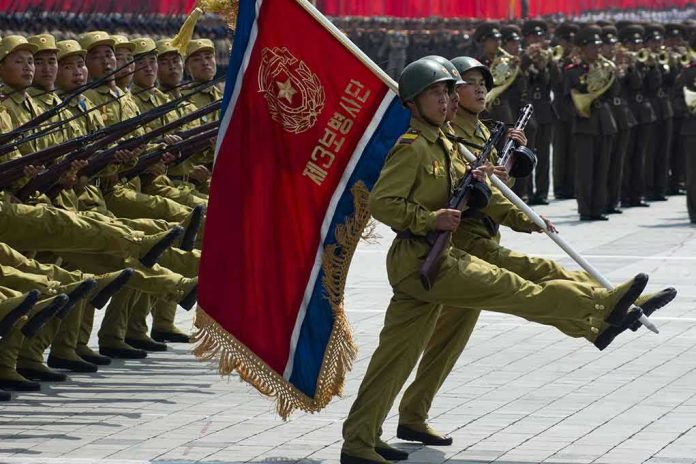
North Korea is ramping up its naval ambitions, but can this rogue nation really pull off a fleet fit to challenge the world’s best?
At a Glance
- North Korea is building advanced Choe Hyon-class destroyers to boost its naval power.
- The regime plans to deploy two destroyers annually starting in 2026.
- These destroyers feature modern missile systems and radar technology.
- The initiative signals a significant shift in regional military balance.
North Korea’s Naval Ambitions: A New Era or Hollow Threat?
North Korea’s naval modernization program is making waves as the country embarks on constructing its third 5,000-ton destroyer, aiming for a 2026 launch. The Choe Hyon-class destroyers represent a significant leap in capability compared to the aging Soviet-era vessels previously relied upon by North Korea. These new destroyers are equipped with modern phased array radar and vertical launch systems, marking the first time such advanced technology has been implemented in a North Korean surface vessel. Kim Jong-un has promised to deploy two of these destroyers or larger each year from 2026, signaling an aggressive push to enhance North Korea’s maritime capabilities and regional influence.
The construction of these destroyers is part of a broader military modernization effort under Kim Jong-un, aimed at projecting power regionally and deterring adversaries. Satellite imagery and open-source intelligence identified the construction of the Choe Hyon-class destroyers in early 2024 at the Nampho and Chongjin shipyards. The first vessel, named Choe Hyon, was launched in April 2025, followed by the second vessel, Kang Kon, in May 2025, despite some technical difficulties that required repairs.
Regional Security at Stake
The Choe Hyon-class destroyers are being built at major shipyards on both the west and east coasts of North Korea, signaling a nationwide effort to bolster naval capabilities. These ships are intended to counter the naval powers of regional adversaries, particularly South Korea and the United States, while enhancing North Korea’s deterrence posture. Historically, North Korea’s navy has focused on smaller missile boats and submarines, but the Choe Hyon-class represents the first large surface combatant of its kind, showcasing a new era of military aspirations.
The failed launch of the second destroyer, Kang Kon, highlights the technical challenges North Korea faces but also underscores the regime’s determination to push forward with rapid development. Despite these hurdles, the North Korean leadership remains committed to its naval modernization agenda, with Kim Jong-un personally overseeing key milestones.
Implications for the Region
The short-term implications of these developments are significant. The successful launch and deployment of these destroyers would represent a major leap in North Korea’s naval capabilities, potentially altering the regional security calculus. While the technical setbacks such as the failed launch of Kang Kon indicate ongoing challenges, they also demonstrate the regime’s resolve to overcome obstacles and achieve its goals.
In the long term, if North Korea succeeds in deploying two destroyers annually, the Korean People’s Navy could field a modern surface fleet within a decade. This would not only challenge regional navies, such as those of South Korea, Japan, and the U.S. Seventh Fleet, but also complicate maritime operations and crisis management in the region. The introduction of vertical launch systems equipped with nuclear-capable missiles could heighten the risk of escalation during a crisis.
Expert Insights and Future Outlook
Industry experts have noted the Choe Hyon-class destroyers’ advanced missile armament and phased array radar as major technological milestones for North Korea. However, they caution that while the ships appear impressive on paper, North Korea’s ability to operate and maintain such complex vessels remains unproven. Analysts also highlight the potential for these destroyers to serve as propaganda tools, as much as military assets, given North Korea’s resource constraints and technical difficulties.
Despite skepticism, the North Korean regime continues to showcase these destroyers as evidence of self-reliance and technological progress. The program may spur regional naval modernization efforts and an arms race, particularly in missile defense and anti-ship warfare. As North Korea presses forward with its ambitious plans, the world will be watching closely to see whether this rogue nation can truly transform its naval power or if these efforts will ultimately prove to be more bluster than substance.
Sources:
GlobalSecurity.org (2025-06-06)
CSIS/Beyond Parallel (2025-06-12)









